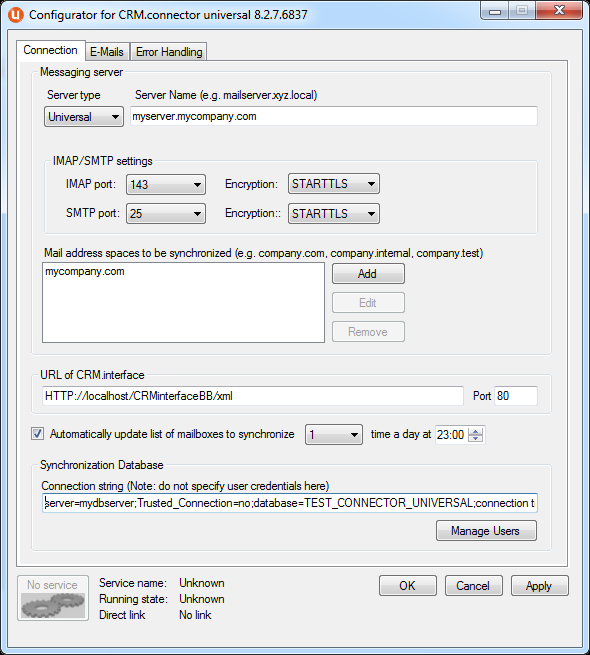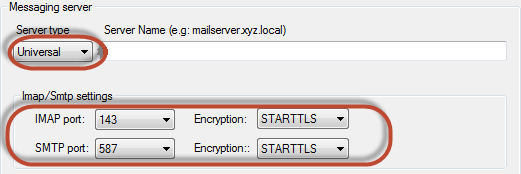Connection Settings
Learn to configure connection settings on the connector dialog box.
In this dialog you can define the basic settings regarding connecting to the messaging system and configuration of CRM.interface.
Connection Settings Dialog

Set the Configuration for the CRM.Connector universal as per the table below:
| Fields | Description |
|---|---|
| Server type | The Server type can be either "Gmail" or "Universal". See chapter Authentication - Access of mailboxes, User management for further details. |
| Hosting Domain or Server name |
Depending on the value you have selected for "Server type", you either have to specify the Hosting Domain (in case of Gmail) or the Server name (in case of all other systems). See Example Configuration |
| IMAP/SMTP settings |
Supported Authentication Methods are:
What method to choose depends on what the target system supports and on how the target
system is configured. E.g. Gmail supports solely port 993 and SSL/TLS for IMAP. See
Example
Configuration.
Note:
|
| Setting "Mail address spaces to be synchronized" | Add all mail address spaces you want to synchronize. If connector comes across e-mail
addresses of a mail space which is not defined to be synchronized, you can find information
concerning this matter in the log
file. |
| URL of CRM.interface | CRM.interface can be either installed on the same or a different machine as connector. |
| Port Number | This setting specifies the port number of CRM.interface; since CRM.interface is running in IIS, the port number is either 80 (or 443 when using HTTPS) by default. |
| Automatically update list of mailboxes to synchronize n time(s) a day |
Updating the list of mailboxes requires re-initialization of connector -which may take a while in a scenario with many users- and therefore can have a huge impact on the duration of synchronization cycles. Therefore it might make sense to consider doing this update only once a day or even switch it off in a scenario in which the user list (users whose mailboxes are supposed to be synchronized) doesn’t change often. If this setting is set to "1" you can additionally schedule when the list should be updated. |
| Connection string to synchronization data base |
The connection string must be built in the following
form:
Note: The attributes
server, database, Trusted_Connection are mandatory;
the connection timeout parameter is optional.
Trusted_Connection must always be set to no. The credentials of the user
are read from users.xml and therefore must not be provided in the
connection string.Examples |
Starting/Stopping Service and applying changed settings to the running service
Starting and Stopping of the Service: Connector service cannot only be restarted using Microsoft Tools but also via the administrative console ("configurator") of the application as well.
At the bottom of the administrative console the "state" of the service is displayed. Possible values are "unknown" or any of the regular states of Windows services (starting, started, stopping, stopped, etc.).
Connection Settings Dialog - Status information
![]()
Applying changed settings to running service: It is possible to apply changed settings to the running service, which means that the service doesn’t need to be restarted to use the new settings. Depending on which configuration has changed, the injection of the new settings causes a full, a partly or even no re-initialization of the service. For example changing the messaging server endpoint causes a full re-initialization.
After the injection the configuration changes are added to the command queue of connector and processed after the connector has finished its current tasks. Typically it won't take more than a few seconds until the new settings are applied by connector. Information on the (re-)initialization progress and result are displayed at the bottom of the dialogue box along with a progress bar.
Example configurations
Connection Settings for Zimbra Collaboration Suite

Connection Settings Open-Xchange

Connection Settings for Zarafa

Connection Settings for Gmail
